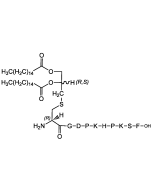Cookie Policy: This site uses cookies to improve your experience. You can find out more about our use of cookies in our Privacy Policy. By continuing to browse this site you agree to our use of cookies.
AdipoGen Life Sciences
(R)-FSL-1
As low as
320
CHF
CHF 320.00
In stock
Only %1 left
AG-CP3-0010-C100100 µgCHF 320.00

| Product Details | |
|---|---|
| Synonyms | Fibroblast-stimulating Lipopeptide; R-Pam2CGDPKHPKSF; (R)-Pam2Cys-Gly-Asp-Pro-Lys-His-Pro-Lys-Ser-Phe-OH |
| Product Type | Chemical |
| Properties | |
| Formula |
C84H140N14O18S |
| MW | 1666.2 |
| CAS | 929905-36-2 |
| Source/Host Chemicals | Synthetic. |
| Purity Chemicals | Absence of detectable protein or DNA contaminants with agonistic TLR activity. |
| Appearance | Colorless powder. |
| Solubility | Soluble in water (10mg/ml). Use a homogeniser or sonicator to prepare a homogenous solution. |
| Reconstitution | Reconstitute in 100μl endotoxin-free water (Prod.No. IAX-900-002) to get a 1mg/ml stock solution. |
| Formulation | Lyophilized. |
| Other Product Data |
Note: FSL-1 stimulation induces a MyD88-dependent signaling cascade leading to the activation of NF-κB and the production of proinflammatory cytokines. FSL-1 exhibits a higher stimulatory activity than MALP-2 when tested for its ability to induce the production of TNF-α in macrophages and NF-κB in TLR2/TLR6 transfected HEK293 cells. Depending on the sensitivity of the in vitro assay, the recommended working concentration for specific stimulation of innate immunity via TLR2/TLR6 heterodimers is 10-100nM. FSL-1 is water soluble in contrast to MALP2. |
| InChi Key | VJJLLNHELGKSNA-QWIIDARVSA-N |
| Smiles | [H][C@@](COC(=O)CCCCCCCCCCCCCCC)(CSC[C@]([H])(N)C(=O)NCC(=O)N[C@@H](CC(O)=O)C(=O)N1CCC[C@H]1C(=O)N[C@@H](CCCCN)C(=O)N[C@@H](CC1=CN=CN1)C(=O)N1CCC[C@H]1C(=O)N[C@@H](CCCCN)C(=O)N[C@@H](CO)C(=O)N[C@@H](CC1=CC=CC=C1)C(O)=O)OC(=O)CCCCCCCCCCCCCCC |
| Shipping and Handling | |
| Shipping | AMBIENT |
| Short Term Storage | +4°C |
| Long Term Storage | -20°C |
| Handling Advice |
After reconstitution, prepare aliquots and store at -20°C. Avoid freeze/thaw cycles. |
| Use/Stability | Stable for at least 2 years after receipt when stored at -20°C. |
| Documents | |
| MSDS |
 Download PDF Download PDF |
| Product Specification Sheet | |
| Datasheet |
 Download PDF Download PDF |
Description
- R-FSL-1 (R-Pam2CGDPKHPKSF) is a synthetic lipoprotein that represents the N-terminal part of the 44kDa lipoprotein LP44 of Mycoplasma salivarium [1].
- The naturally occurring R-stereoisomer is biologically more active than the S-stereoisomer [4].
- Stimulator of TLR2/TLR6 [2-13].
- Inducer of TNF-α production in macrophages [5].
- Upregulates proinflammatory cytokines [3,5].
- Activator of the proinflammatory transcription factor NF-κB [3].
Product References
- The N-terminal lipopeptide of a 44-kDa membrane-bound lipoprotein of Mycoplasma salivarium is responsible for the expression of intercellular adhesion molecule-1 on the cell surface of normal human gingival fibroblasts: K.I. Shibata, et al.; J. Immunol. 165, 6538 (2000)
- Discrimination of bacterial lipoproteins by Toll-like receptor 6: O. Takeuchi, et al.; Int. Immunol. 13, 933 (2001)
- Relationship between structures and biological activities of mycoplasmal diacylated lipopeptides and their recognition by Toll-Like Receptors 2 and 6: T. Okusawa, et al.; Infect. Immun. 72, 1657 (2004)
- Involvement of suppressors of cytokine signaling in toll-like receptor-mediated block of dendritic cell differentiation: H. Bartz, et al.; Blood 108, 4102 (2006)
- Effects of repeated injections of fibroblast-stimulating lipopeptide-1 on fever, formation of cytokines, and on the responsiveness to endotoxin in guinea-pigs: A. Greis, et al.; Acta Physiol. 197, 35 (2009)
- Regulators of G-protein signalling are modulated by bacterial lipopeptides and lipopolysaccharide: S. Riekenberg, et al.; FEBS J. 276, 649 (2009)
- Toll-like receptors and innate immunity: H. Kumar, et al.; BBRC 388, 621 (2009)
- Lipoteichoic Acid Induces Unique Inflammatory Responses when Compared to Other Toll-Like Receptor 2 Ligands: E.M. Long, et al.; PLoS One 4, e5601 (2009)
- A new cell-based innate immune receptor assay for the examination of receptor activity, ligand specificity, signalling pathways and the detection of pyrogens: A. Burger-Kentischer, et al.; J. Immunol. Methods 358, 93 (2010)
- Toll-like receptor 2 (P631H) mutant impairs membrane internalization and is a dominant negative allele: G.E. Etokebe, et al.; Scand. J. Immunol. 71, 369 (2010)
- TLR2 stimulation drives human naive and effector regulatory T cells into a Th17-like phenotype with reduced suppressive function: M.H. Nyirenda, et al.; J. Immunol. 187, 2278 (2011)
- A subclass of acylated anti-inflammatory mediators usurp Toll-like receptor 2 to inhibit neutrophil recruitment through peroxisome proliferator-activated receptor gamma: E.M. Long, et al.; PNAS 108, 16357 (2011)
- Activation of endothelial TLR2 by bacterial lipoprotein upregulates proteins specific for the neutrophil response: K. Wilhelmsen, et al.; Innate Immun. 18, 602 (2012)
- FcεR1-mediated mast cell reactivity is amplified through prolonged Toll-like receptor-ligand treatment: R. Saluja, et al.; PLoS One 7, e43547 (2012)






